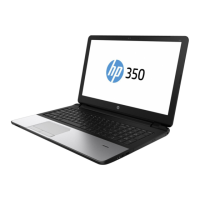Creating recovery media with HP Recovery Disc Creator
NOTE: Your computer may not come equipped with an internal optical drive. In order to create the recovery
DVD, you may need to plug in an external optical drive.
HP Recovery Disc Creator is a software program that offers an alternative way to create recovery media.
After you successfully set up the computer, you can create recovery media using HP Recovery Disc Creator.
This recovery media performs a system recovery if the hard drive becomes corrupted. A system recovery
reinstalls the original operating system and the software programs installed at the factory, and then
configures the settings for the programs.
HP Recovery Disc Creator can create two kinds of recovery DVDs as follows:
●
Windows DVD—Installs the operating system without additional drivers or applications. Choosing this
selection creates a DVD that restores the original operating system and the software programs
installed at the factory.
●
Driver DVD—Installs specific drivers and applications only, in the same way that the HP Software Setup
utility installs drivers and applications.
Creating recovery media
NOTE: Operating system recovery media can be created only once. Thereafter, the option to create that
media will not be available.
1. Select Start > All Programs > Security and Protection > HP Recovery Disc Creator.
2. Select Driver DVD or Windows DVD.
3. From the drop-down menu, select the drive for burning the recovery media.
4. Click the Burn button to start the burning process.
Backing up your information
Recovery after a system failure is as good as your most recent backup. Immediately after software setup,
you should create system repair discs (select models only) using HP Recovery Disc Creator using the installed
optical drive (select models only) or an optional external optical drive and back up your system. As you add
new software and data files, you should continue to back up your system on a regular basis to maintain a
reasonably current backup. The system repair discs (select models only) are used to start up (boot) the
computer and repair the operating system in case of system instability or failure. Your initial and subsequent
backups allow you to restore your data and settings if a failure occurs.
You can back up your information to an optional external hard drive, a network drive, or discs.
Note the following when backing up:
●
Store personal files in the Documents library, and back it up regularly.
●
Back up templates that are stored in their associated programs.
●
Save customized settings that appear in a window, toolbar, or menu bar by taking a screen shot of your
settings. The screen shot can be a time-saver if you have to reset your preferences.
●
When backing up to discs, use any of the following types of discs (purchased separately): CD-R, CD-RW,
DVD+R, DVD+R DL, DVD-R, DVD-R DL, or DVD±RW. The discs you use will depend on the type of optical
drive you are using.
NOTE: Your computer may not come equipped with an internal optical drive. In order to create back up
discs, you may need to plug in an external optical drive.
92 Chapter 9 Backup and recovery

